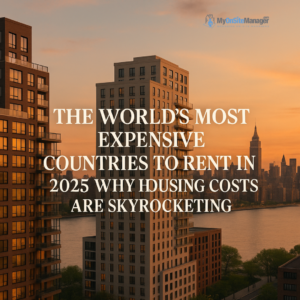Renting a home is an unavoidable reality for millions worldwide, but in some countries, the price of securing a roof over your head has skyrocketed to unprecedented levels. According to recent rankings, countries like Switzerland, Singapore, and Hong Kong dominate the list of the world’s most expensive rental markets, driven by limited housing supply, high demand, and strong economic conditions.
This report highlights the nations where renters are feeling the tightest squeeze in 2025, and what’s driving these soaring prices.
1. Switzerland – A Benchmark for Costly Living
Switzerland consistently tops global cost-of-living charts, and rent is a major contributor. With cities like Zurich, Geneva, and Basel attracting international talent and multinational corporations, housing demand outpaces supply.
-
Average Rent: A one-bedroom apartment in Zurich can cost $3,000–$4,000 per month, while Geneva can be even higher.
-
Why So Expensive? High wages, a strong Swiss Franc, and strict building regulations limit new construction, further pushing up costs.
-
Lifestyle Premium: While expensive, Switzerland offers unmatched quality of life—efficient public transport, safety, and breathtaking natural beauty.
2. Singapore – High-Tech Hub, High Rents
Singapore is one of the world’s financial powerhouses, but the cost of living, particularly rent, has risen sharply due to limited land space and heavy foreign demand.
-
Average Rent: A one-bedroom apartment in the city center averages around $2,900–$3,500 per month.
-
Why So Expensive? The island nation’s compact size means housing supply is tight. Government policies favor home ownership, leaving expats competing for limited rental stock.
-
Tip for Renters: Many expats look at areas like Woodlands or Punggol to find more affordable housing without sacrificing quality.
3. Hong Kong – Where Space Comes at a Premium
Hong Kong has long been synonymous with expensive real estate. Apartments are not only costly but also notoriously small.
-
Average Rent: A modest city-center apartment can easily cost HKD 30,000/month (~USD 3,800+).
-
Why So Expensive? Limited land and high population density make Hong Kong’s rental market one of the tightest globally.
-
Living Trend: Micro-apartments—some as small as 200 sq. ft.—are becoming increasingly common.
4. Bahamas – Paradise with a Price Tag
The Bahamas is a dream destination, but living in paradise comes with high costs, particularly due to import-driven expenses.
-
Average Rent: Prices vary, but urban areas and tourist hubs often exceed $2,000 per month for small apartments.
-
Why So Expensive? Almost all goods, including building materials, are imported. This pushes up costs across the board, including housing.
-
Fun Fact: Dining out for two can cost $130 or more, excluding rent.
5. Iceland – Small Population, Big Costs
Iceland has seen a surge in global tourism, and this demand has spilled into the housing market, driving up rents for locals.
-
Average Rent: A one-bedroom apartment in Reykjavik can cost $1,800–$2,300 per month.
-
Why So Expensive? Limited housing development, combined with the country’s remote location, means both construction and living expenses are high.
-
Renter Tip: Long-term rentals outside Reykjavik are cheaper but often come with higher commute costs.
6. Norway and Denmark – Nordic Quality at a Price
The Nordic countries are renowned for their high quality of life and strong social systems, but that quality comes with high costs.
-
Average Rent (Norway): Oslo’s city center averages $2,000+ per month for small apartments.
-
Average Rent (Denmark): In Copenhagen, expect $1,700–$2,300 per month.
-
Why So Expensive? Strong economies, limited urban land, and strict tenant protections contribute to higher rental prices.
7. United States – Not the Most Expensive, but Still Costly
While not at the very top of the global list, the U.S. ranks 10th for rental costs.
-
Average Rent: City-center one-bedrooms average $1,741/month, but cities like New York and San Francisco exceed $3,000/month.
-
Trends: Rising interest rates and limited new housing construction have tightened rental supply.
8. Australia and Canada – Expensive Urban Centers
Both countries have seen housing markets surge, particularly in major cities.
-
Australia: Sydney and Melbourne lead the way, with average city-center rents exceeding $2,000/month.
-
Canada: Vancouver and Toronto have similarly high costs, often surpassing $2,500/month for one-bedroom units.
Why Are These Countries So Expensive to Rent?
Several common factors emerge:
-
High Demand, Low Supply: Urbanization and international migration increase competition for limited housing stock.
-
Economic Strength: Wealthier countries tend to have higher costs due to stronger currencies and wage levels.
-
Geography: Islands or small nations like Singapore and Iceland face construction constraints and costly imports.
-
Tourism: In places like Iceland or the Bahamas, short-term vacation rentals reduce availability for long-term renters.
Tips for Navigating High-Rent Countries
-
Look Outside City Centers: Suburban or neighboring towns often offer 30–50% lower rents.
-
Shared Housing: Flat-sharing or co-living is becoming popular among young professionals in high-rent cities.
-
Negotiate Longer Leases: Landlords may provide better rates for stability.
-
Use Cost-of-Living Calculators: Tools like Numbeo or Expatistan can help budget realistically before relocating.
Final Thoughts
From the pristine lakes of Switzerland to the vibrant streets of Hong Kong, living in these nations can be a dream—but that dream comes with a steep price tag. Understanding the dynamics behind rental prices can help renters plan better, whether they are relocating for work, study, or lifestyle.
Source: Ranked: The World’s Most Expensive Countries to Rent – MSN Money

